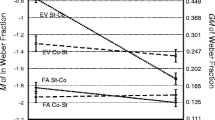Abstract
Two experiments were conducted to test the effect of nontemporal factors on duration discrimination. In Exp. 1, a forced-choice adaptive procedure with a standard duration of 400 or 800 ms was employed. It was shown that, for both auditory and visual modes, the discrimination is better with empty intervals (a silent period between two brief signals) than with filled intervals (a continuous signal), but only with shorter durations. In a second experiment, where intervals of the same duration range were employed but were presented with a single-stimulus method, discrimination was better with empty than with filled intervals, and this effect applied to both ranges of duration and both sensory modes. In both experiments, discrimination was better in the auditory than in the visual mode. These data are discussed in the context of current models of timing mechanisms.
Similar content being viewed by others
Author information
Authors and Affiliations
Additional information
Received: 16 October 1997 / Accepted: 30 April 1998
Rights and permissions
About this article
Cite this article
Grondin, S., Meilleur-Wells, G., Ouellette, C. et al. Sensory effects on judgments of short time-intervals. Psychological Research Psychologische Forschung 61, 261–268 (1998). https://doi.org/10.1007/s004260050030
Issue Date:
DOI: https://doi.org/10.1007/s004260050030




